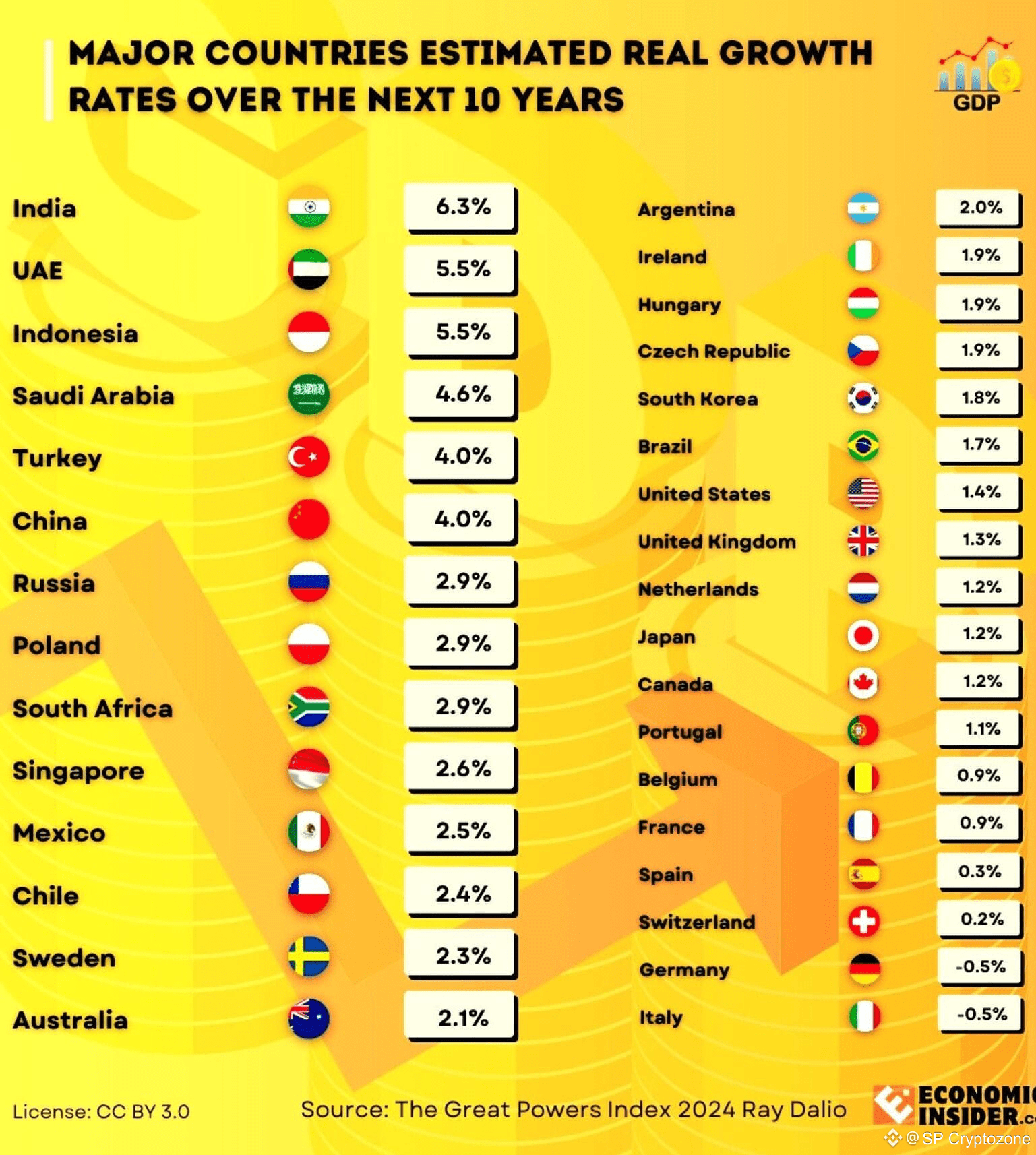🌍 Global Economic Expansion and Shifting Power Dynamics: A Decade's Perspective.

Ray Dalio's The Great Powers Index 2024 takes a comprehensive look at 24 of the most important economies in the world and evaluates their economic strength, national health, general happiness, and growth potential. The index estimates these nations' real growth trajectories over the next ten years using indicators like GDP, share of global trade, life expectancy, and rates of chronic illness.
Countries like India, China, the United States, the United Kingdom, Japan, Canada, Poland, Hungary, and Russia are all included in this analysis.
The findings indicate that India is the major economy that is expected to grow at the fastest rate, with an average real growth rate of 6.3% over the next decade. Germany and Italy, on the other hand, are expected to experience negative growth of -0.5%, indicating stagnation throughout the Eurozone.
🌐 Estimates of major economies' real growth rates over the next 10 years: Real growth rate of the nation
🇮🇳 India 6.3%
🇦🇪 UAE 5.5%
🇮🇩 Indonesia 5.5%
🇸🇦 Saudi Arabia 4.6%
🇹🇷 Turkey 4.0%
🇨🇳 China 4.0%
🇷🇺 Russia 2.9%
🇵🇱 Poland 2.9%
🇿🇦 South Africa 2.9%
🇸🇬 Singapore 2.6%
🇲🇽 Mexico: 2.5%
🇨🇱 Chile 2.4%
🇸🇪 Sweden's 2.3%
🇦🇺 Australia 2.1%
🇦🇷 Argentina 2.0%
🇮🇪 Ireland: 1.9%
🇭🇺 Hungary: 1.9%
🇨🇿 Czech Republic 1.9%
🇰🇷 South Korea 1.8%
🇧🇷 Brazil 1.7%
🇺🇸 United States 1.4%
🇬🇧 United Kingdom1.3%
🇳🇱 Netherlands: 1.2%
🇯🇵 Japan 1.2%
🇨🇦 Canada 1.2%
🇵🇹 Portugal: 1.1%
🇧🇪 Belgium: 0.9%
🇫🇷 France 0.9%
🇪🇸 Spain 0.3%
🇨🇭 Switzerland 0.2%
🇩🇪 Germany: -0.5%
🇮🇹 Italy -0.5%
Overview of the Economic Outlook. It is anticipated that developed economies will experience sluggish growth, primarily as a result of their high debt levels, aging populations, and slower productivity gains. In the meantime, resource optimization, youthful demographics, and rising innovation capacity are anticipated to drive robust expansion in emerging markets like India, China, Indonesia, and Brazil.
🇺🇸 The United States
With a GDP of roughly $30 trillion, the United States of America continues to be the world's leading economic powerhouse, supported by its financial strength, military dominance, and status as a reserve currency. But over the past two decades, its overall momentum has slowed down. The U.S. economy is expected to expand by around 1.4% annually, ranking it fourth among advanced nations and 22nd among 35 major economies.
🇨🇳 China
China's manufacturing capacity, technological development, and trade dominance continue to exert enormous global influence, making it the second-largest economy with a GDP of $18.53 trillion. China's economy is expected to continue expanding at a rate of 4% annually, placing it sixth among emerging economies and sixth among 35 major economies.
🇩🇪 Germany
Germany faces headwinds from energy transitions, demographic challenges, and a slowdown in industrial output despite being the third-largest economy in the world. Its forecast for growth is -0.5 percent, which places it 34th out of 35 economies and is one of the worst performances among advanced nations.
🇮🇳 India
India ranks fifth globally with a GDP of $3.94 trillion, supported by its large labor force, rapid digital adoption, and substantial domestic consumption. India's projected 6.3% annual real growth rate positions it as the world's fastest-growing major economy, ranking first among 35 economies and first among emerging markets, despite issues like corruption and regulatory bottlenecks.
📈 As a conclusion
There is a clear divide in the global growth landscape for the next ten years:
🔹 Global expansion will be driven by emerging markets, led by China, India, and Indonesia.
🔹 Developed economies may experience stagnation or contraction, particularly Germany and Italy.
In essence, the economic weight of the 2030s appears to be shifting decisively in the direction of Asia and the Global South, indicating a new phase in the balance of economic power on the global scale.
